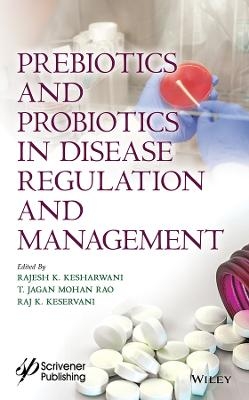
Prebiotics and Probiotics in Disease Regulation and Management
Wiley-Scrivener (Verlag)
978-1-394-16627-5 (ISBN)
- Titel ist leider vergriffen;
keine Neuauflage - Artikel merken
The demand for biobased products is increasing enormously, among which are prebiotic oligosaccharides and probiotics, which occupy a major share of the food industry. Even though the majority of agro waste is currently being used for the production of 2G biofuels, agro waste such as citrus peel, sugar beet pulp, copra meal, and wheat husk can be considered for the production of prebiotic oligosaccharides. Prebiotics are dietary fibers that are selectively fermented by the microbes present in the gut and promote the growth of beneficial bacteria in the intestine and regulate the growth of harmful bacteria.
The book highlights the importance of nutraceuticals (prebiotics, and probiotics) in maintaining gut homeostasis, prevention, and treatment of gut-related disorders, as anti-cancer agents, immune-modulatory agents, and treatment of metabolic disorders. It brings out the current challenges involved in the formulation and development of nutraceuticals, together with the application of nanotechnology and bioinformatics-based approaches to study the effect of nutraceuticals on oral health, and gut microflora in a very precise way.
Audience
The book will be read by food scientists and biotechnologists, as well as researchers in nutraceuticals and food processing research companies, nutraceutical/supplement product developers, and those in pharmaceutical companies.
Rajesh K. Kesharwani, PhD, is an associate professor in the Department of Computer Application, Nehru Gram Bharati (Deemed to be University), Prayagraj, India. He has more than 11 years of research and 9 years of teaching experience in various institutes in India. He has authored more than 55 peer-reviewed articles, 24 book chapters, and edited 15 books. His research fields of interest are medical informatics, protein structure and function prediction, computer-aided drug designing, structural biology, drug delivery, cancer biology, nano-biotechnology, and biomedical sciences. T. Jagan Mohan Rao, PhD, is an assistant professor in the Department of Biotechnology, NIT, Andhra Pradesh, India. He has research experience in the synthesis and production of poly and oligosaccharides. In his postdoctoral research in Brazil, he produced prebiotic oligosaccharides in orange juice by using an immobilized and co-immobilized enzyme system, while in South Korea, he worked on prebiotic properties of pectic polysaccharides using standard intestinal bacterial cultures and published his research findings in reputed international SCI-Journals. Raj K. Keservani, MPharm, is an associate professor in the Faculty of B. Pharmacy, CSM Group of Institutions, Prayagraj, India. He has more than 12 years of academic (teaching) experience from various institutes in India in pharmaceutical education. He has published more than 30 peer-reviewed papers in the field of pharmaceutical sciences in national and international journals, 1 patent, 43 book chapters, three co-authored books, and 19 edited books. His research interests include nutraceutical and functional foods, novel drug delivery systems (NDDS), transdermal drug delivery/drug delivery, health science, cancer biology, and neurobiology.
Preface xiii
1 Role of Probiotics in Treatment of Gut-Related Diseases 1
Kunal Kumar and Rajani Sharma
1.1 Introduction 1
1.1.1 Major Gut-Related Diseases and Probiotics Interaction 2
1.1.2 Metabolism in Probiotics 8
1.1.3 Sources of Probiotics 8
1.2 Nutrition Enrichment by Probiotics 8
1.3 Symbiotic Relation of Probiotics in the Gut 9
1.3.1 Mechanism of Interaction 10
1.3.2 Escaping Mechanism of Probiotics From Immune Cells 11
1.4 Probiotics Role in Boosting Host Immunity 11
1.5 Commercial Probiotic Products Possessing Beneficial Properties 12
1.5.1 Probiotics in Dairy Products 12
1.5.2 Fermentation of Fruit Juices With Fortified Probiotic Lactobacilli 14
1.5.3 Probiotics as Pharmaceutics 14
1.6 Controversial/Side Effects of Probiotics 22
1.7 Conclusion 22
1.8 Future Prospect 22
References 22
2 Immune Response of Fructo and Galacto-Oligosaccharides 27
Muthu Vijayasarathy, Yesudass Antony Prabhu, Selvan Pavithra, Selvaraj Jothi Prabha and Tingirikari Jagan Mohan Rao
Abbreviations 28
2.1 Introduction 29
2.2 Sources of FOS and GOS 30
2.3 Synthesis of FOS and GOS 31
2.4 Bifidogenesis of FOS and GOS 32
2.5 Mechanisms of Oligosaccharides Mediated Immune Effects 33
2.5.1 Intestinal Immune Cells 33
2.5.2 Intestinal Epithelial Barrier 36
2.5.3 Microbiota-Dependent Effects of Oligosaccharides 37
2.5.3.1 Indirect Effect of Oligosaccharides on Intestinal Epithelial Cells 37
2.5.3.2 An Indirect Effect of Oligosaccharides on Immune Cells 40
2.5.4 Microbiota Independent Effects of Oligosaccharides 41
2.5.4.1 Direct Effect on Intestinal Epithelial Cells 41
2.5.4.2 Direct Effects on Immune Cells 44
2.6 Immunomodulatory Effects of Fructooligosaccharides and Galactooligosaccharides 45
2.6.1 Gastrointestinal Disease 45
2.6.2 Immune Stimulation 46
2.6.3 Allergy 48
2.6.4 Mineral Absorption 48
2.6.5 Inflammatory Bowel Diseases 49
2.6.6 Cancer 49
2.6.7 Cholesterol and Triglyceride Reduction 50
2.7 Conclusion 51
Acknowledgment 51
References 51
3 Human Mucosal Organ and Application of Probiotics 61
Tanuja Mohanty, Bhanu Pratap Gurjar and Usha Nagarajan
3.1 Introduction 62
3.2 Mode of Action of Probiotics on Human Mucosa 63
3.2.1 Bifidobacterium 65
3.2.2 Streptococcus 66
3.2.3 Lactobacillus 67
3.3 Application of Probiotics 69
3.3.1 Probiotics for Gastrointestinal Disorders 70
3.3.1.1 Inflammatory Bowel Syndrome 70
3.3.1.2 Colon Cancer 77
3.3.1.3 Gastric Ulcers 78
3.3.1.4 Acute Gastroenteritis 78
3.3.2 Probiotics for Respiratory Disorders 79
3.3.2.1 Asthma 79
3.3.2.2 Cerebral Ischemia/Reperfusion Injury 81
3.3.2.3 Cystic Fibrosis and Chronic Obstructive Pulmonary Disease (COPD) 82
3.3.2.4 Viral Infection (Mainly SARS-CoV-2) 83
3.3.3 Application of Probiotics on Ageing-Related Mucus Impairment 84
3.4 Conclusion 85
Acknowledgment 85
References 86
4 Prebiotics and Probiotics as Anticancer Therapeutics 95
Dixita Chettri, Ashwani Kumar Verma and Anil Kumar Verma
Abbreviations 95
4.1 Introduction 96
4.2 Prebiotic vs Probiotic 97
4.2.1 Definition and Difference 99
4.2.2 Criteria for Use as a Dietary Supplement 99
4.2.3 Source/Method of Administration 104
4.3 Prebiotics and Probiotics Association with Gut Microbiota and Human Health 104
4.3.1 Role of the Gut Microbiota in Overall Human Health 105
4.3.2 Prebiotic and Probiotic Influence on Gut Microbiome Composition 107
4.4 Cancer 109
4.4.1 Procarcinogens and Carcinogens 110
4.4.2 Types of Cancer 111
4.4.2.1 Colorectal Cancer (CRC) 111
4.4.2.2 Gastric Cancer 112
4.4.2.3 Pancreatic Cancer 112
4.4.2.4 Prostate Cancer 113
4.4.2.5 Breast Cancer 114
4.4.2.6 Skin Cancer 114
4.5 Anticancer Potential of Probiotics and Prebiotics 114
4.5.1 Clinical Evidences 115
4.5.1.1 Clinical Evidence for the Anticancer Potential of Probiotics 115
4.5.1.2 Clinical Evidences for Anticancer Potential of Prebiotics 124
4.5.2 Safety and Quality Control Assurance 125
4.6 Conclusion and Future Prospect 127
Acknowledgment 127
References 127
5 Application of Nanotechnology in Formulation of Nutraceuticals 133
Pradnya Jadhav, Sakshi Kor and Shadab Ahmed
5.1 Introduction 134
5.2 Delivery System 137
5.2.1 Lipid-Based Delivery System 138
5.2.1.1 Nanoemulsions 138
5.2.1.2 Nanoliposomes 139
5.2.1.3 Solid Lipid Nanoparticles (SLN) and Nanostructured Lipid Carriers (NLC) 140
5.2.2 Polysaccharide-Based Delivery System 141
5.2.2.1 Polymeric Nanoparticle 142
5.2.2.2 Polymeric Micelle 143
5.2.3 Protein-Based Delivery System 143
5.3 Advantages of Nanotechnology in Nutraceuticals 144
5.4 Why are Nanoparticles or Nanomaterials Used? 144
5.5 Applications and Advantages of Nanotechnology to Improve the Specific Quality 144
5.6 Challenges Faced During Production of Nutraceuticals Using Nanotechnology 149
5.7 Conclusion and Future Prospects 152
References 152
6 Challenges in Development of Prebiotic and Probiotics 161
Pradnya Jadhav, Sakshi Kor and Shadab Ahmed
6.1 Introduction 161
6.1.1 Probiotics, Prebiotics, and Synbiotics 162
6.1.1.1 Probiotics 162
6.1.1.2 Prebiotics 163
6.1.1.3 Synbiotics 164
6.1.2 History of Probiotics and Prebiotics 164
6.2 Current Use of Probiotics and Prebiotics for Health Benefits 166
6.2.1 Prebiotic and Probiotic Health Benefits 166
6.2.1.1 Prebiotics Uses in Health Benefits 166
6.2.1.2 Probiotics Uses in Health Benefits 169
6.2.2 Prebiotics and Probiotics Used in Combinatorial Approach for Health Benefits 171
6.2.3 Limitations of Probiotics 172
6.3 Development of New Generation of Probiotics/Prebiotics 173
6.3.1 Development of New Generation of Probiotics 173
6.3.2 New Prebiotics With Improved Effect on GIT Microbiota for Health Benefits 174
6.3.3 Improvement in Viability of Probiotics 174
6.3.4 Current Trends and Scope for Development 176
References 176
7 Immunostimulatory Role of Prebiotics and Probiotics 185
Tanuja Mohanty, Bhanu Pratap Gurjar, Sudheer BabuYangala and Usha Nagarajan
7.1 Introduction 186
7.2 Prebiotics 186
7.2.1 Galacto-Oligosaccharides (GOS) 188
7.2.2 Fructo-Oligosaccharides and Polysaccharides 191
7.2.3 Raffinose 192
7.2.4 Human Milk Oligosaccharides 192
7.2.5 Flavanols 193
7.2.6 Polyunsaturated Fatty Acids 194
7.3 Probiotics 194
7.4 Role of Prebiotics and Probiotics in Immunorelated Diseases 198
7.4.1 Multiple Sclerosis (MS) 198
7.4.2 Respiratory Tract Infections 199
7.4.3 Cardiovascular Disease (CVD) 202
7.4.4 Type 1 Diabetes (T1D) 204
7.4.5 Colorectal Cancer 205
7.4.6 Inflammatory Bowel Diseases 207
7.4.7 Rheumatoid Arthritis (RA) 208
7.4.8 Muscle Wasting 209
7.5 Conclusion 209
Acknowledgment 210
References 210
8 Bioinformatics and Advanced Research in Gut Microflora 219
Arabinda Ghosh, Muddukrishnaiah Kotakonda, VedantVikrom Borah and Nobendu Mukerjee
8.1 Introduction 220
8.2 Computational and Metagenomic Approaches 221
8.3 Antibiotic Resistance Genes Have Been Revealed in the Gut Microbiota of People Across the Globe 223
8.4 Microbiota in the Human Intestine 224
8.5 Probiotics Modes of Action 225
8.6 Exclusion from Competition 225
8.7 Bacterial Antagonism 226
8.8 Antibacterial Activity 226
8.9 Neutralization of Pathogenic Bacteria-Produced Enterotoxins 226
8.10 Immune Modulation 226
8.11 Adhesion to the Digestive System Wall to Prevent Harmful Bacteria From Colonizing 227
8.12 Competing with Pathogenic Bacteria for Nutrients in the Gut 227
8.13 Metagenomics in Microbiome and Probiotics Research 227
8.14 Microbiome and Probiotics Research Challenges 229
8.15 Potential Prebiotic Screening for Promoting Probiotic Health 230
8.15.1 Extraction and Characterization of Prebiotics 230
8.15.2 Screening Prebiotics for Probiotic Growth Promotion 231
8.15.3 Database System for Prebiotic Research 232
8.16 Conclusion 232
References 234
9 Prebiotics and Probiotics in Regulation of Metabolic Disorders 239
Manswama Boro, Sushruta Bhadra and Anil Kumar Verma
Abbreviations 240
9.1 Introduction 240
9.2 Probiotics 241
9.3 Prebiotics 245
9.4 The Role of Gut Microbiota in Metabolic Disorders 246
9.4.1 Obesity 246
9.4.2 Diabetes 248
9.4.3 Liver Disorders 249
9.4.4 Cardiometabolic Disorders 250
9.5 Effect of Prebiotics on Metabolic Disorders 251
9.5.1 Mechanism of Action 251
9.5.2 Prebiotics With Other Components 253
9.6 Effect of Probiotics on Metabolic Disorders 256
9.6.1 Role of Probiotics on Obesity 259
9.6.2 Role of Probiotics on Diabetes 259
9.6.3 Role of Probiotics on Cardiovascular Disease (CVD) 260
9.6.4 Role of Probiotics on Acute Liver Injury (ALI) 262
9.6.5 Engineering Probiotics for Targeted Therapeutics 262
9.7 Conclusion and Future Prospect 263
Acknowledgment 264
References 264
10 Developing Formulations of Prebiotics and Probiotics 271
Eknath D. Ahire, Nisha Sharma, Prakash Chandra Gupta, Shubham Khairnar, Khemchand Surana, Bhavana Ahire, Vijayraj Sonawane, Umesh Laddha, Sneh Sonkamble, Rahul Sabale and Sanjay Kshirsagar
10.1 Introduction 272
10.2 Probiotics 272
10.3 Prebiotics 275
10.4 Synbiotics 278
10.5 Challenges for New Probiotic and Prebiotic-Based Foods 279
10.6 Production of Probiotics at a Low Cost 282
10.7 Improving Viability of Probiotics 282
10.8 Conclusions 284
Acknowledgment 285
References 285
11 Oral Health and Prebiotics 291
Khemchand Surana, Eknath D. Ahire, Ritesh Pawar, Ritesh Khairnar, Sunil Mahajan, Sanjay Kshirsagar, Swati G. Talele, Nilima Thombre, Bhavana Ahire and Raj K. Keservani
11.1 Introduction 292
11.1.1 Prebiotic 292
11.1.2 Prebiotic Selection Criteria 293
11.1.3 Prebiotics Mechanism of Action 294
11.2 Oral Microbiota in Health and Disease 296
11.2.1 Functions of Resident Microbiota 296
11.2.2 Microbiota Responsible for Oral Diseases 296
11.2.3 Is Prebiotics Considered a Feasible Substitute for the Treatment of Oral Diseases? 297
11.2.4 Classification of Prebiotic 298
11.3 Nitrate as Potential Prebiotic for Oral Health 305
11.4 Commercial Product of Prebiotic on Oral Health 307
11.5 Future Viewpoint 307
11.6 Conclusion 307
Acknowledgement 307
References 308
Index 311
| Erscheinungsdatum | 15.09.2022 |
|---|---|
| Sprache | englisch |
| Maße | 10 x 10 mm |
| Gewicht | 454 g |
| Themenwelt | Naturwissenschaften ► Biologie |
| Naturwissenschaften ► Chemie | |
| Technik | |
| ISBN-10 | 1-394-16627-3 / 1394166273 |
| ISBN-13 | 978-1-394-16627-5 / 9781394166275 |
| Zustand | Neuware |
| Informationen gemäß Produktsicherheitsverordnung (GPSR) | |
| Haben Sie eine Frage zum Produkt? |
aus dem Bereich


